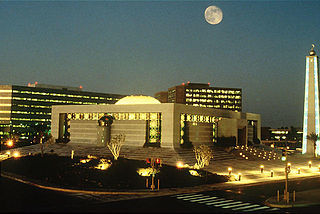
For all the talk of Saudi Arabia’s oil company becoming the first trillion-dollar business if it goes public, some see the chatter as a sign of oil’s weakness. The Saudis, they say, know it’s time to start hedging their bet on fossil fuels.
While the Saudi Arabian Oil Co. sits on a preposterously large reserve of 260 billion barrels of oil, the kingdom’s discussion of a share sale amid a global collapse in crude prices suggests another motive to those who preach about the financial risks of climate change: The Saudis may want to capitalize on an asset that’s only going to lose value if the world gets serious about global warming.
“Why would you IPO your only valuable asset when oil is at its lowest point since 2003?” said Andrew Logan of Ceres, the Boston-based coalition of investors and environmentalists. “The most obvious way to read it is they are starting to see the writing on the wall — that the age of oil is coming to an end and they are looking to cash out while they can.”
In the short-term, Saudi Arabia has as an advantage over other oil producers because it has some of the world’s lowest costs. Other, more expensive sources of crude — deepwater fields and Canadian oil sands, for example — are likely to fall by the wayside first. But the reserves under the kingdom’s desert will be viable for decades even if world leaders have agreed to move away from fossils fuels in a bid to limit global warming.
The risk to Saudi Arabia’s oil wealth isn’t only seen by organizations like Ceres, a nonprofit that prods companies to adopt “sustainable leadership.” It’s a view shared by Fadel Gheit, a veteran oil analyst at Oppenheimer & Co. in New York and former group leader for research and engineering at Mobil Oil Corp.
Competition from U.S. shale producers may be a more pressing concern, but the Saudis are “absolutely” thinking about climate-inspired constraints as they consider the company’s future, Gheit said.
“Saudi Arabia is lining up some funding sources in anticipation of a very prolonged environment of low oil prices,” the analyst said by telephone. “If I’m running an oil company, I’m running for the hills.”
Crude oil fell to a new 12-year low below $30 a barrel in New York on Friday morning as concern mounted about new flows from Iran coming to market as economic sanctions end.
Officials at Saudi Aramco, as the state-run business is known, didn’t immediately reply when asked for comment. The company confirmed last week that it’s considering options for a share sale — from a full public offering to a listing of selected units. Based on its estimated reserves, analysts suggest it could have a market value in the trillions, which would make it the world’s biggest company.
The question is how long those reserves will retain their value.
A month ago, almost 200 nations, including Saudi Arabia, agreed to a landmark pact in Paris to rein in the greenhouse-gas emissions that are blamed for global warming, chief among them pollution from burning coal, oil and natural gas.
To have even a 50:50 shot of keeping global temperature increases to 2 degrees Celsius, the goal set in Paris, more than two-thirds of current fossil fuel reserves will have to remain in the ground, according to a 2014 report by the Intergovernmental Panel on Climate Change, the world’s leading body of climate scientists. At current emission levels, the world’s “budget” for burning fossil fuels would be exhausted in less than 20 years.
“The last thing you want is to have a whole lot of oil left at the end of the oil age,” said Logan, who directs Ceres’s oil, gas and insurance program.
Gheit, the Oppenheimer analyst, estimated 90 percent of Saudi Aramco’s value lies in its crude reserves, as opposed to downstream refining and other operations.
Still, Saudi Aramco’s cost advantage shouldn’t be easily dismissed, said James Leaton, a research director at the Carbon Tracker Initiative. The London-based group studies the effects of climate change and policy on capital markets.
Assuming only the cheapest, easiest-to-reach oil is extracted in a scenario that caps temperature increases at 2 degrees Celsius (3.6 degrees Fahrenheit), about 7 percent of the Saudi company’s projects would be scuttled over the next decade, accounting for about $12 billion in capital expenditures, Leaton said in a phone interview.
“The majority of its projects would still fit within a 2- degree scenario,” Leaton said. Private-sector companies “have greater exposure to those high-cost projects at the wrong end of the cost curve: the oil sands, the deep-water, the Arctic and so-on. That’s where we see the pressure coming.”
Climate constraints are only one issue facing the Saudis, Leaton said. The desire to sell is driven by the country’s need to help balance a budget that’s been ravaged by the decline in oil prices, he said.
Saudi Arabia’s deputy crown prince, Mohammed bin Salman, acknowledged the need to diversify the nation’s economy beyond oil, in an interview with The Economist last week. He cited mining and religious tourism as two areas of potential growth. The kingdom has also tried to develop its reserves of natural gas, a less polluting fossil fuel, and has invested in solar technology.
“The signal from Paris is to reduce demand for fossil fuels, so you can’t keep increasing supply and fit that trajectory,” said Leaton. Even so, “there’s obviously a bit of tension between a policy of maximizing supply and potentially selling your business if the oil price isn’t high.”